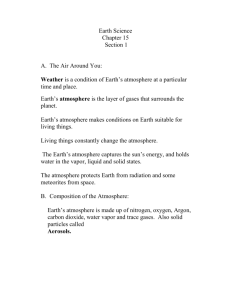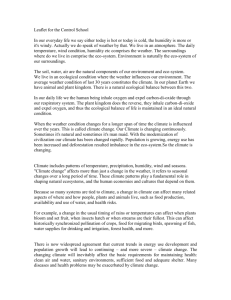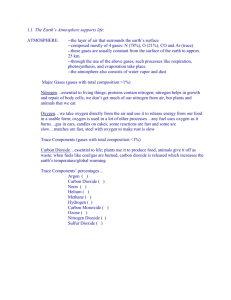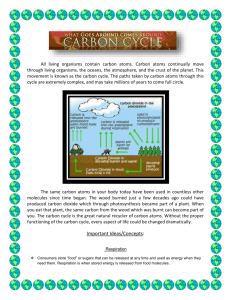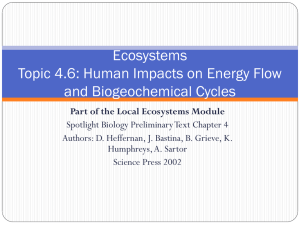HUMAN IMPACTS ON THE NITROGEN CYCLE
advertisement
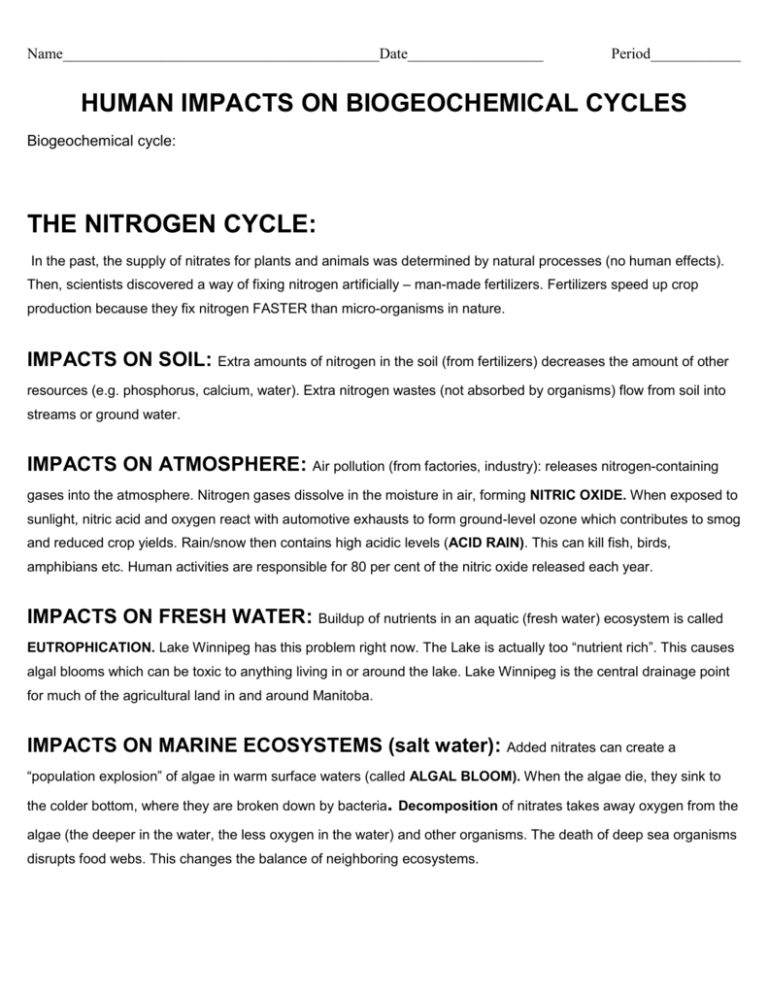
Name__________________________________________Date__________________ Period____________ HUMAN IMPACTS ON BIOGEOCHEMICAL CYCLES Biogeochemical cycle: THE NITROGEN CYCLE: In the past, the supply of nitrates for plants and animals was determined by natural processes (no human effects). Then, scientists discovered a way of fixing nitrogen artificially – man-made fertilizers. Fertilizers speed up crop production because they fix nitrogen FASTER than micro-organisms in nature. IMPACTS ON SOIL: Extra amounts of nitrogen in the soil (from fertilizers) decreases the amount of other resources (e.g. phosphorus, calcium, water). Extra nitrogen wastes (not absorbed by organisms) flow from soil into streams or ground water. IMPACTS ON ATMOSPHERE: Air pollution (from factories, industry): releases nitrogen-containing gases into the atmosphere. Nitrogen gases dissolve in the moisture in air, forming NITRIC OXIDE. When exposed to sunlight, nitric acid and oxygen react with automotive exhausts to form ground-level ozone which contributes to smog and reduced crop yields. Rain/snow then contains high acidic levels (ACID RAIN). This can kill fish, birds, amphibians etc. Human activities are responsible for 80 per cent of the nitric oxide released each year. IMPACTS ON FRESH WATER: Buildup of nutrients in an aquatic (fresh water) ecosystem is called EUTROPHICATION. Lake Winnipeg has this problem right now. The Lake is actually too “nutrient rich”. This causes algal blooms which can be toxic to anything living in or around the lake. Lake Winnipeg is the central drainage point for much of the agricultural land in and around Manitoba. IMPACTS ON MARINE ECOSYSTEMS (salt water): Added nitrates can create a “population explosion” of algae in warm surface waters (called ALGAL BLOOM). When the algae die, they sink to the colder bottom, where they are broken down by bacteria. Decomposition of nitrates takes away oxygen from the algae (the deeper in the water, the less oxygen in the water) and other organisms. The death of deep sea organisms disrupts food webs. This changes the balance of neighboring ecosystems. Name__________________________________________Date__________________ Period____________ HUMAN IMPACT ON THE CARBON CYCLE CARBON DIOXIDE AND GREENHOUSE GASES: Carbon dioxide is a greenhouse gas and traps heat in the atmosphere. We need some carbon dioxide (and other greenhouse gases: see below) in our atmosphere or Earth would be a frozen world. But humans have added about 30% more carbon dioxide in the air today than there was about 150 years ago. The CO2 influx among land, sea and atmosphere is from burning of fossil fuels, agriculture and deforestation (burning trees and decomposing organic matter).Adding to the problem of increasing carbon dioxide are increases in other atmospheric gases, especially methane (CH4). Its major sources are ruminant animals (cows), microbial decomposition in swamps, marshes and tundra and industrial gases released to the atmosphere. GREENHOUSE GASES AND THE GLOBAL CLIMATE: CO2 in the atmosphere absorbs long wave, or thermal radiation. Atmospheric CO2 and water vapor trap this thermal energy, warming the atmosphere. CO2 is not the only greenhouse gas increasing in concentration as a result of human activity. Other greenhouse gases include methane (CH4), chloroflurocarbons (CFC’s), hydrogenated chloroflurocarbons (HCFCs), nitrous oxide (N2O) ozone (O3), and sulfur dioxide (SO2). Global warming is more than just our Earth’s average temperature increasing. Global precipitation will increase, there will be increased variability in climate (including more storms and hurricanes, greater snowfall and increased variability in rainfall). Species that do not adapt easily may have a difficult time surviving because of this.



